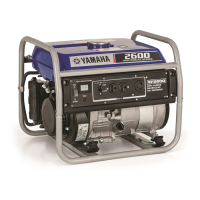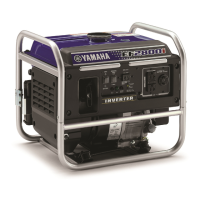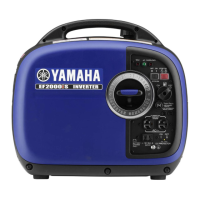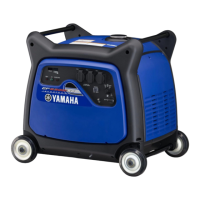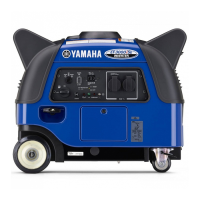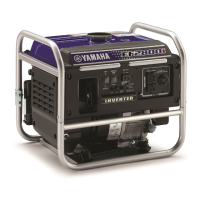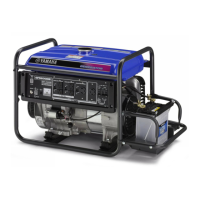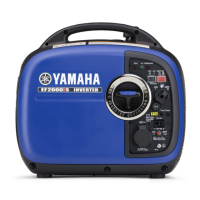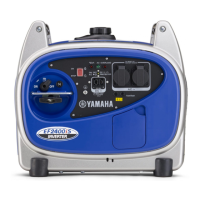Do you have a question about the Yamaha YG4000D and is the answer not in the manual?
Field for recording Generator's Primary I.D. Number.
Record Primary I.D. and serial numbers for spare parts and theft prevention.
Location of machine serial number and its digits for model identification.
Details warranty duration, general and specific exclusions for EF/EDL series generators.
Outlines owner's duties and procedures for warranty transfer.
Details warranty duration, general and specific exclusions for EC/YG series generators.
Outlines owner's duties and procedures for warranty transfer for EC/YG series.
Provides contact info for customer service and procedures for changing address for warranty registration.
Identifies and explains important labels on the EF4000DE and YG4000D models.
Identifies and explains important labels on specific generator models.
Warns about poisonous exhaust fumes and safe operating conditions.
Details hazards related to flammable and poisonous fuel and safe refueling practices.
Alerts users about hot engine and muffler surfaces to prevent burns.
Advises against operating in rain/snow and touching with wet hands to prevent shock.
Explains the importance and method of grounding the generator for safety.
Warns against connecting to commercial outlets or other generators.
Emphasizes using a licensed electrician for transfer switch installation to prevent backfeeding.
Provides guidelines on extension cord length and type for safe generator use.
Identifies and describes the controls for EF4000DE, EF5200DE, EF6600DE models.
Identifies and describes the controls for YG4000D, YG5200D, YG6600D, YG6600DE models.
Explains the components and functions of the control box for specific models.
Explains the components and functions of the control box for specific models.
Explains how the oil warning system functions and alerts the user.
Describes the operation of the engine switch for starting and stopping the engine.
Details the function of the starter switch for the YG6600DE model.
Explains the function of the AC switch (Non-Fuse Breaker) and its automatic trip mechanism.
Describes how the economy idle switch improves fuel efficiency and reduces noise.
Explains how to adjust the output voltage to the rated voltage using the adjuster.
Describes the G.F.C.I. receptacle's safety function and how to test it.
Details the procedure for checking the fuel level and recommended fuel type.
Specifies recommended engine oil types, classifications, and quantities for different models.
Emphasizes the importance of grounding the generator and refers to safety information.
Guides on installing the battery, connecting terminals, and handling precautions.
Provides initial notes before starting the engine, like filling oil.
Details the step-by-step process for starting the generator's engine.
Outlines the steps for starting the engine using the electric start system.
Details the steps for starting the engine using the manual recoil starter.
Lists the AC power output, power factor, and application wattage for various models.
Guides on connecting AC devices, checking voltage meter, and turning on switches.
Details specific AC switch operations for YG models and 4-blade receptacle usage.
Explains when to turn the economy idle switch OFF for optimal engine speed.
Details the correct steps for safely shutting down the generator engine.
Provides a comprehensive chart detailing maintenance items and their recommended service intervals.
Lists further maintenance items like fuel line, choke lever, cooling system, and their checks.
Details how to inspect, gap, and torque the spark plug.
Advises that carburetor adjustment should be performed by a qualified dealer.
Guides on draining old oil, replacing the drain plug, and refilling with new oil.
Details the procedure for cleaning, oiling, and installing the air filter element.
Explains how to clean and inspect the fuel cock and its components.
Details the process for cleaning the fuel tank filter.
Guides on removing, cleaning, and inspecting the muffler screen and spark arrester.
Details cleaning procedures for muffler components on specific models.
Covers checking for damage, aligning, and reinstalling muffler components.
Explains how to check and replenish the battery fluid using distilled water.
Details how to replace a blown fuse with the correct amperage.
Guides on testing the Ground Fault Circuit Interrupter receptacle for correct operation.
Provides steps to diagnose why the engine may not be starting, covering fuel, oil, and electrical issues.
A flowchart to diagnose engine starting issues for EF/YG models.
Guides on checking engine oil level and spark plug condition for troubleshooting.
A flowchart for diagnosing engine starting issues specific to YG models.
Details the procedure for draining fuel from the tank and carburetor for long-term storage.
Explains how to prepare the engine for storage by oiling the cylinder and cleaning the exterior.
Provides instructions for storing and charging the battery to maintain its condition.
Lists the recommended battery capacity and voltage for the generators.
Lists components of the exhaust emission control system and their acronyms.
Provides physical dimensions and dry weight for various generator models.
Lists engine type, displacement, bore x stroke, rated output, and fuel capacity.
Details AC output, voltage, frequency, current, rated output, and safety device type.
Provides instructions for installing the battery tray on specific generator models.
Guides on installing engine hangers for specific generator models.
Details the installation process for the optional two wheel kit.
Explains how to complete and mail the warranty registration form for accurate record-keeping.
| Model | YG4000D |
|---|---|
| Engine Displacement | 212 cc |
| Rated AC Voltage | 120/240V |
| Frequency | 60 Hz |
| Engine Type | 4-stroke, OHV |
| Starting System | Recoil |



